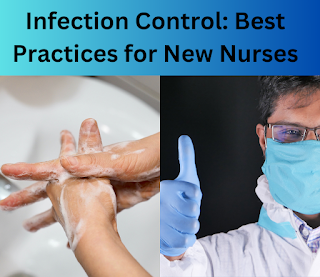Infection Control: Best Practices for New Nurses
Infection Control: Best Practices for New Nurses
Overview
Infection Control: Best Practices for New Nurses -The foundation of healthcare is infection control, and it is essential for new nurses to comprehend these procedures. It reduces the spread of infections, safeguards healthcare personnel, and guarantees patient safety. Acquiring expertise in these areas establishes the foundation for a successful nursing career, whether it involves manual cleaning or utilizing state-of-the-art technology.
Comprehending Infection Control
Infection control: what is it?
The term "infection control" describes the rules, guidelines, and methods used to stop and manage the spread of illnesses in medical environments. Breaking the cycle of infection—from the infectious agent to the vulnerable host—is its main goal.
Infection Types in Medical Environments
Healthcare-associated infections, or HAIs, include C. difficile and MRSA.
Community-Associated Infections: These infections are brought into hospitals from outside sources.
Odd-Selection Infections: Aim for patients with impaired immune systems.
The Significance of Infection Control and Its Effect on Patient Safety
Infection management improves recovery rates, decreases complications, and shortens hospital stays. It has a direct effect on health outcomes and patient happiness.
Ethical and Legal Obligations
It is the ethical duty of healthcare professionals to keep their patients safe. Legal repercussions and eroded patient confidence may result from noncompliance with infection control procedures.
Hand Hygiene Procedures: How to Wash Your Hands Effectively with Five Movements of Hand Hygiene
clean water on wet hands.
After using soap, give it a decent lather and scrub for at least 20 seconds.
Rinse and either air dry or pat dry with a fresh towel.
Use of Hand Sanitizer: When and Why
Although hand sanitizers work well against a variety of infections, they shouldn't be used in place of hand washing when hands are obviously unclean.
Gloves are one type of personal protective equipment (PPE).
Respirators and masks
Face shields and gowns
Appropriate PPE Use and Disposal
Make sure the PPE fits properly.
Used PPE should be disposed of in the appropriate biohazard bins.
Safe Procedures for Injection
Steer clear of cross-contamination.
For every injection, use a fresh syringe and needle to reduce the possibility of cross-contamination.
Methods for Handling Sharps Properly
To prevent unintentional accidents, dispose of needles and sharps right away in containers that can withstand punctures.
Cleaning and disinfecting patient areas as part of environmental hygiene
High-touch areas like equipment, doorknobs, and bed rails should be routinely cleaned.
Handling Polluted Linens
To stop infections from being aerosolized, bag linens at the source and don't shake them.
Precautions for Isolation
Comprehending Airborne, Droplet, and Contact Precautions
Depending on the mode of transmission, different precautions are needed, necessitating specialized management strategies.
The function of patient cohorting
Patients with similar infections can be grouped together to stop the infection from spreading to other susceptible people.
The Function of Vaccines for Medical Personnel
In order to protect themselves and others, frontline workers must get vaccinations like the COVID-19 and flu shots.
Protocols for Immunization of Patients
By informing patients about immunization regimens, the risk of avoidable illnesses is decreased.
In conclusion
Healthcare workers share responsibility for infection control. By following these guidelines, new nurses can protect themselves as well as their patients. You can make a big difference in infection prevention by being knowledgeable, working with others, and adopting a safety culture.
FAQ
1. Which infection control procedure is most important for nurses?
The best defense against infection transmission is excellent hand cleanliness.
2. How frequently is PPE supposed to be changed?
PPE needs to be changed after each patient encounter or when it becomes obviously dirty.
3. Can immunizations make infection control procedures unnecessary?
No, immunizations are not a substitute for other infection prevention practices like wearing personal protective equipment (PPE) or practicing excellent hand hygiene.
4. How should I respond if I come across opposition to infection control procedures?
Cite evidence to support the significance of these steps, and if necessary, raise issues with your supervisor.
5. Are there any technologies that aid in the prevention of infections?
Indeed, instruments like electronic monitoring systems and UV sterilizers improve infection control procedures.
The best defense against infection transmission is excellent hand cleanliness.
2. How frequently is PPE supposed to be changed?
PPE needs to be changed after each patient encounter or when it becomes obviously dirty.
3. Can immunizations make infection control procedures unnecessary?
No, immunizations are not a substitute for other infection prevention practices like wearing personal protective equipment (PPE) or practicing excellent hand hygiene.
4. How should I respond if I come across opposition to infection control procedures?
Cite evidence to support the significance of these steps, and if necessary, raise issues with your supervisor.
5. Are there any technologies that aid in the prevention of infections?
Indeed, instruments like electronic monitoring systems and UV sterilizers improve infection control procedures.




%20(1).png)


.png)





Comments
Post a Comment